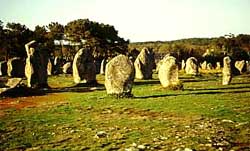DK History: Megalithic Europe
Between c. 3200 BC and 1500 BC, peoples in northwest Europe began to build monuments from massive stones known as megaliths. Some were arranged in circles or lines, pointing to the sky. Others, called CHAMBER TOMBS, were buried under the earth.
Megalithic monuments came in many different shapes and sizes. Most were fairly small, and could easily have been assembled by a family over a few seasons. Large monuments, like Stonehenge and Carnac, were probably built by powerful chiefs who could command their subjects to work on the monuments.
Stone circles were probably used for religious ceremonies or for astronomy. Most of them line up with the Sun, Moon, and stars on special days. For example, the rising Sun shines through the center of Stonehenge, England, at midsummer, and lights up a chamber tomb in Newgrange, Ireland, at midwinter.
Megalithic tombs with several chambers (rooms) were built using massive stone slabs, then covered with an earth mound called a barrow. Each one could be used as a burial place for hundreds of years.
Archaeologists are not certain for whom the chamber tombs were made, because they were robbed long ago. From their design, it seems likely that they were used to bury rich, powerful leaders, who controlled vast areas of farmland and the people living in the region.

